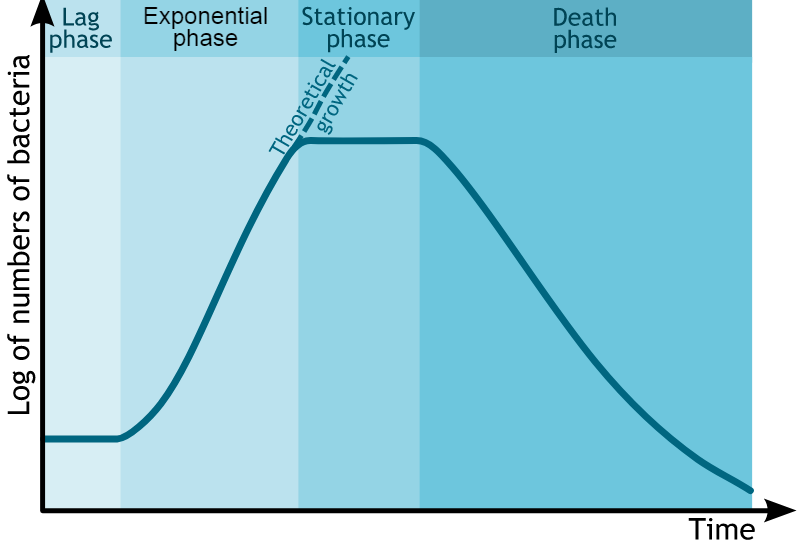
Exponential growth is shown during
A. Lag phase
B. Log phase
C. Maturation phase
D. Senescence phase
Answer
404.1k+ views
Hint: Exponential growth is the process by which quantity increases over time. It occurs when the instantaneous rate of change of a quantity concerning time is proportional to the quantity itself. A quantity undergoing exponential growth is an exponential function of time, that is, the variable representing time is the exponent (in contrast to other types of functions).
Complete answer:
Bacterial growth is the division of a bacterium into two daughter cells, a process known as binary fission. In the absence of an event, the resulting daughter cells are genetically identical to the original cell. As a result, bacterial growth occurs. Both daughter cells from the division may or may not survive. However, if the average number of survivors exceeds one, the bacterial population will become unstable.
Bacterial growth is classified into four stages: the lag phase, the log phase, the stationary phase, and the death phase. Bacterial growth is minimal or non-existent during the lag phase. Bacteria are adjusting to their surroundings and synthesizing biochemicals and nutrients during this stage. The number of bacterial cells doubles at an exponential rate during the log phase.
This phase is characterized by maximum or exponential growth. The rate of cell death is equal to the rate of cell division in the stationary phase. The bacterial population decreases during the death phase due to a lack of nutrients and a high toxin concentration.
So, The log phase (also known as the logarithmic phase or the exponential phase) is a period in which cells double. The number of new bacteria that appear per unit time is proportional to the size of the current population. If growth is unrestricted, doubling will occur at a constant rate, doubling both the number of cells and the rate of population increase with each successive period.
Thus, The answer is option B: log phase.
Bacterial growth curve is given as:

Note:
Acidity (pH), temperature, water activity, macro, and micronutrients, oxygen levels, and toxins are all environmental factors that influence the rate of bacterial growth. Except for extremophiles, bacteria have relatively consistent environmental conditions. The bacterium thrives in optimal growth conditions, but once outside of those conditions, stress can result in reduced or stalled growth, dormancy (such as spore formation), or death. A key principle of food preservation is to maintain suboptimal growth conditions.
Complete answer:
Bacterial growth is the division of a bacterium into two daughter cells, a process known as binary fission. In the absence of an event, the resulting daughter cells are genetically identical to the original cell. As a result, bacterial growth occurs. Both daughter cells from the division may or may not survive. However, if the average number of survivors exceeds one, the bacterial population will become unstable.
Bacterial growth is classified into four stages: the lag phase, the log phase, the stationary phase, and the death phase. Bacterial growth is minimal or non-existent during the lag phase. Bacteria are adjusting to their surroundings and synthesizing biochemicals and nutrients during this stage. The number of bacterial cells doubles at an exponential rate during the log phase.
This phase is characterized by maximum or exponential growth. The rate of cell death is equal to the rate of cell division in the stationary phase. The bacterial population decreases during the death phase due to a lack of nutrients and a high toxin concentration.
So, The log phase (also known as the logarithmic phase or the exponential phase) is a period in which cells double. The number of new bacteria that appear per unit time is proportional to the size of the current population. If growth is unrestricted, doubling will occur at a constant rate, doubling both the number of cells and the rate of population increase with each successive period.
Thus, The answer is option B: log phase.
Bacterial growth curve is given as:

Note:
Acidity (pH), temperature, water activity, macro, and micronutrients, oxygen levels, and toxins are all environmental factors that influence the rate of bacterial growth. Except for extremophiles, bacteria have relatively consistent environmental conditions. The bacterium thrives in optimal growth conditions, but once outside of those conditions, stress can result in reduced or stalled growth, dormancy (such as spore formation), or death. A key principle of food preservation is to maintain suboptimal growth conditions.
Recently Updated Pages
Class 10 Question and Answer - Your Ultimate Solutions Guide

Master Class 10 Science: Engaging Questions & Answers for Success

Master Class 10 Maths: Engaging Questions & Answers for Success

Master Class 9 General Knowledge: Engaging Questions & Answers for Success

Master Class 10 General Knowledge: Engaging Questions & Answers for Success

Master Class 9 English: Engaging Questions & Answers for Success

Trending doubts
The gas that burns in oxygen with a green flame is class 12 chemistry CBSE

The probability that a leap year will have only 52 class 12 maths CBSE

Describe the poetic devices used in the poem Aunt Jennifers class 12 english CBSE

And such too is the grandeur of the dooms We have imagined class 12 english CBSE

What does the god that failed refer to class 12 english CBSE

Which country did Danny Casey play for class 12 english CBSE




